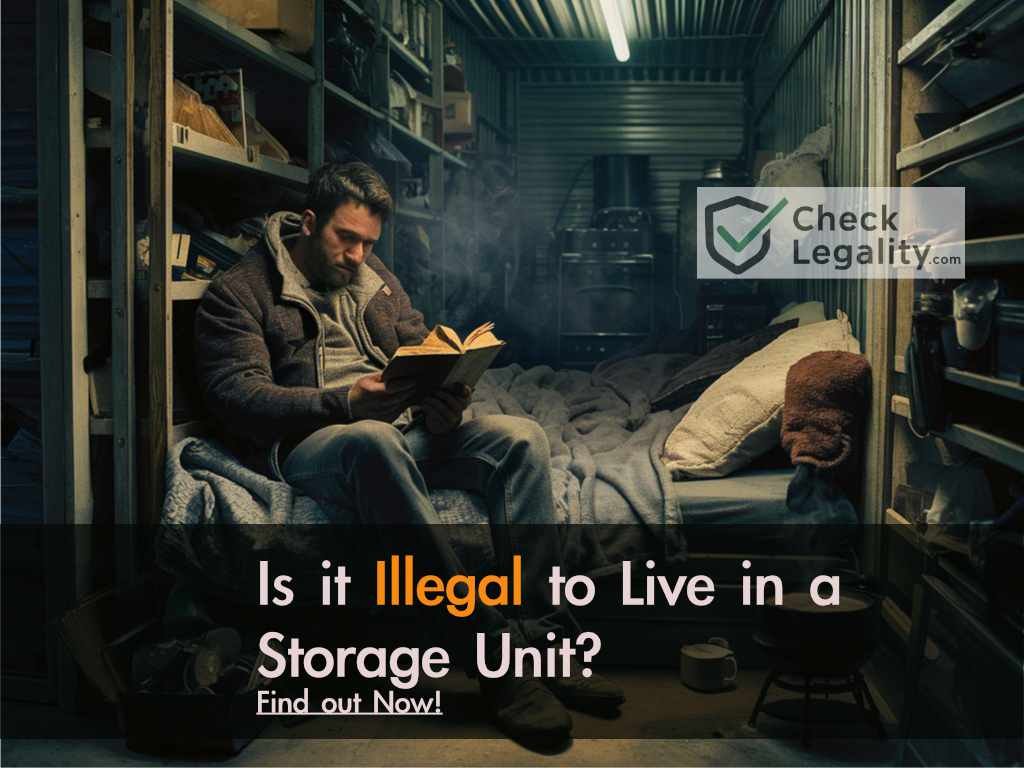Check Legality Summary:
Is it illegal to live in a storage unit? While no federal law explicitly prohibits it, this article explores this approach’s dangers and legal complexities. Living in a storage unit exposes you to safety hazards like fire risks and unsanitary conditions. The legality varies by state, with most strictly forbidding it and others allowing it under specific circumstances.
Finding affordable housing can be a significant challenge in many areas. Rental prices continue to rise, and securing an apartment can be lengthy. This situation can leave individuals struggling with temporary housing solutions.
Is it illegal to Live in a Storage Unit?
Storage units offer conveniently sized, secure spaces often rented on a monthly basis. While primarily used for storing belongings, furniture, or seasonal items, storage units might seem like a tempting option for someone facing a temporary housing shortage. However, the question arises: Is it legal to live in a storage unit?
The Legality and Safety Concerns:
Unlike residential dwellings, storage units aren’t designed for human habitation. This raises concerns about the legality and safety of living in one. There’s no universal law explicitly addressing this issue, and the legality can vary depending on your location.
The Dangers of Living in a Storage Unit
While the idea of living in a storage unit might seem like a temporary solution during a housing crisis, the dangers associated with this approach are significant. These dangers can cause serious health problems and safety hazards.
Let’s explore some of the key concerns surrounding storage unit habitation:
A. Safety Concerns:
- Lack of Ventilation and Carbon Monoxide Poisoning: Storage units typically lack proper ventilation systems. This can lead to a concentration of carbon monoxide, a colorless and odorless gas. Inhaling high concentrations of carbon monoxide can be fatal. Symptoms of carbon monoxide poisoning can be easily mistaken for the flu, making it even more dangerous.
- Inadequate Fire Safety Measures and Limited Escape Routes: Storage units often lack fire alarms, sprinkler systems, or proper fire exits. In the event of a fire, this lack of safety measures can create a dangerous situation with limited escape options. The quick-spreading nature of fires in enclosed spaces further increases the risk of serious injury or death.
- Electrical Hazards: The electrical wiring in storage units might not be designed to handle the demands of household appliances. Overloading circuits or using improper extension cords can lead to electrical fires. These electrical hazards pose a significant risk of injury and property damage.
- Exposure to Extreme Temperatures: Storage units are often not insulated and can become extremely hot during summers and freezing cold in winters. These extreme temperatures can be dangerous, especially for vulnerable individuals such as children, the elderly, and individuals with pre-existing health conditions. Heatstroke and hypothermia are serious health risks associated with exposure to extreme temperatures.
- Increased Vulnerability to Crime: Storage facilities might not have the same level of security as residential buildings. The limited access control and potentially isolated location of storage units can make them more susceptible to break-ins and other crimes. Living in a storage unit can increase your vulnerability to criminal activity.
- Unsanitary Conditions: Storage units are not designed for human habitation and may lack proper sanitation facilities. This can lead to the growth of mold, mildew, and pests. Living in unsanitary conditions can cause respiratory problems, skin irritations, and other health issues.

B. Mental and Emotional Health Impacts:
Beyond the physical dangers, living in a storage unit can negatively impact mental and emotional well-being. Here’s how:
- Feelings of Isolation and Loneliness: Storage units’ cramped and isolated nature can lead to feelings of isolation and loneliness. The lack of quality social interaction and human connection can significantly impact mental health.
- Increased Stress and Anxiety: The uncertainty and instability of living in a storage unit can be a significant source of stress and anxiety. Worrying about eviction, safety concerns, and the lack of a permanent living situation can take a toll on mental well-being.
- Potential for Mental Health Issues, Depression, and Others: The combined effects of isolation, stress, and unhealthy living conditions can contribute to depression and other mental health issues. If you’re considering living in a storage unit, it’s crucial to understand and monitor the potential impact on your mental health.
Legality of Living in a Storage Unit: A State-by-State Analysis
The lack of a federal law explicitly prohibiting living in storage units creates a complex legal landscape. Regulations regarding storage unit habitation primarily fall under the jurisdiction of individual states. Understanding the legalities in your specific location is crucial before considering this option.
A. Absence of a Federal Law:
There is no overarching federal law explicitly outlawing living in storage units. This means that the legality of this practice is determined at the state and local levels. Building codes, zoning regulations, and occupancy permits play a significant role in assessing the permissibility of using storage units for residential purposes.
B. Zoning Laws and Occupancy Permits:
- Zoning Laws: Zoning laws define how the land can be used in specific areas. Typically, areas designated for commercial storage facilities would have zoning restrictions prohibiting residential use. Living in a storage unit located in such a zoned area would likely be considered a violation.
- Occupancy Permits: Residential dwellings require occupancy permits that certify the structure meets safety and habitability standards. Based on these regulations, storage units lack these permits and wouldn’t be considered suitable living spaces.
C. Examining State Laws and Legal Precedents:
To illustrate the varied legal landscape across states, let’s explore some contrasting approaches:
State 1 (Living Allowed with Restrictions):
- A state like California might have specific regulations allowing for temporary storage unit occupancy under certain controlled conditions. These conditions could involve ensuring proper ventilation is installed, meeting fire safety requirements, and adhering to specific limitations on occupancy duration.
- Legal precedents in this state might involve documented cases where individuals received permission to temporarily reside in a storage unit while adhering to these strict regulations and safety measures.
State 2 (Living Strictly Prohibited):
- A state like Texas might have clear laws explicitly prohibiting living in storage units. The legal code might define this as a violation, outlining potential consequences like eviction and fines.
- Court cases in this state could involve instances where individuals faced legal repercussions for attempting to reside in storage units.

State 3 (Unclear Regulations):
- In a state like Florida, the legality of living in a storage unit might be a grey area. The regulations might be unclear or not strictly enforced.
- This ambiguity could lead to situations where individuals attempt to live in storage units under the radar, but the legal risk and potential consequences remain unclear.
State 4 (Focus on Enforcement):
- A state like New York might have regulations prohibiting habitation in storage units, with a focus on enforcement. Storage facility operators could face penalties for knowingly allowing tenants to live in their units.
- This approach emphasizes the responsibility of storage facility owners to ensure their units are not used for residential purposes.
Important Note: These are just a few examples, and it’s vital to research your state’s specific laws and regulations. You can typically find the relevant information on your state’s official government website.
Remember: Even if there’s a legal grey area in your state, the dangers associated with living in a storage unit remain significant. It’s crucial to prioritize own health and safety by exploring safer alternatives.
Alternatives to Living in a Storage Unit
Facing housing insecurity can be a stressful and challenging experience. While living in a storage unit might seem like a temporary solution, the dangers and legal complexities associated with this approach make it a risky option. Fortunately, there are safer and legal alternatives to consider:
A. Government Assistance Programs:
Several government agencies offer programs to assist individuals and families facing housing insecurity. Here are some resources to explore:
- U.S. Department of Housing and Urban Development (HUD): The HUD website provides information on various housing assistance programs, including:
- Emergency Shelters: These shelters offer temporary housing and basic necessities for families and individuals experiencing homelessness.
- Transitional Housing Programs: These programs provide temporary housing with supportive services to help individuals find permanent housing and achieve self-sufficiency.
- Section 8 Housing Choice Voucher Program: The HCVP provides rent assistance to low-income families and individuals to help them afford decent, safe, and sanitary housing in the private market.
- National Low Income Housing Coalition (NLIHC): This non-profit organization advocates for affordable housing policies and offers resources to connect individuals with potentially helpful programs.
B. Non-Profit Organizations and Charities:
Many non-profit organizations and charities work tirelessly to assist individuals and families facing homelessness or housing insecurity. These organizations can offer a variety of resources, including:
- Shelters and Emergency Services: Similar to HUD-supported shelters, these organizations provide temporary housing and essential services like meals, clothing, and healthcare referrals.
- Food Banks and Meal Programs: These programs offer food assistance to families and individuals struggling to afford food.
- Financial Aid Programs: Some non-profit organizations might offer financial assistance to help individuals secure housing deposits or rental payments.
C. House-Sharing and Roommate Options:
House-sharing or finding roommates can be a cost-effective way to secure temporary or long-term housing. Here are some resources to explore:
- Online Platforms: Websites and apps like Craigslist, Apartments.com, or roommate-finding services can help connect you with potential roommates or shared living opportunities.
- Community Bulletin Boards: Local community centers or bulletin boards might offer postings for individuals seeking roommates or shared housing arrangements.
Conclusion:
Finding affordable housing can be challenging, but living in a storage unit is not the answer. This approach is not only legally risky but also poses significant health and safety risks. The resources listed above offer a better path forward. Reach out for support, explore safer alternatives, and prioritize your well-being. With effort and perseverance, you can find secure and legal housing solutions.
Conclusion and Resources
Recap:
Throughout this article, we explored the critical aspects of living in a storage unit:
- Dangers: We highlighted the numerous safety and health hazards associated with storage unit habitation, including lack of ventilation, fire risks, exposure to extreme temperatures, unsanitary conditions, and increased vulnerability to crime. We also discussed the potential negative impacts on mental and emotional well-being.
- Legality: We emphasized the absence of a universal law and the importance of understanding state-by-state regulations. We analyzed zoning laws, occupancy permits, and legal precedents from various states with contrasting approaches, showcasing the complexity of the legal landscape.
- Alternatives: Recognizing the dangers and legal complexities of inhabiting storage units, we explored a range of safer and legal alternatives. These included government assistance programs, support offered by non-profit organizations, house-sharing arrangements, and access to crisis hotlines and mental health services.
A Message of Hope and Encouragement:
While facing housing insecurity can be a deeply challenging experience, it’s important to remember that you are not alone. There are resources available to help you find safe and secure housing. Reach out to the organizations listed below, and don’t hesitate to seek support from friends, family, or trusted individuals.
Government Agencies:
- U.S. Department of Housing and Urban Development (HUD):https://www.hud.gov/
- Provides information on various housing assistance programs, including emergency shelters and transitional housing.
- National Low Income Housing Coalition (NLIHC):https://nlihc.org/
- Offers resources and advocacy for affordable housing options.
Non-Profit Organizations:
- National Alliance to End Homelessness:https://endhomelessness.org/
- Works to prevent and end homelessness in the United States.
- Habitat for Humanity:https://www.habitat.org/
- A non-profit that helps build and repair homes for low-income families.
Shelters and Crisis Services:
- National Coalition for the Homeless: https://nationalhomeless.org/
We recommend you to consult with legal aid or housing advocacy organizations in your specific area to understand the legalities of living in a storage unit and explore available resources tailored to your situation.


